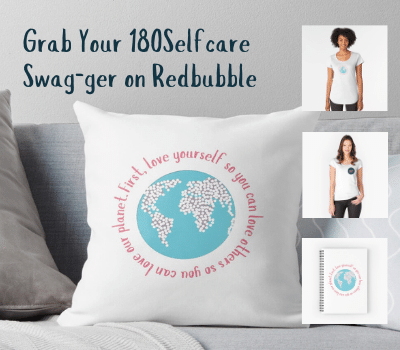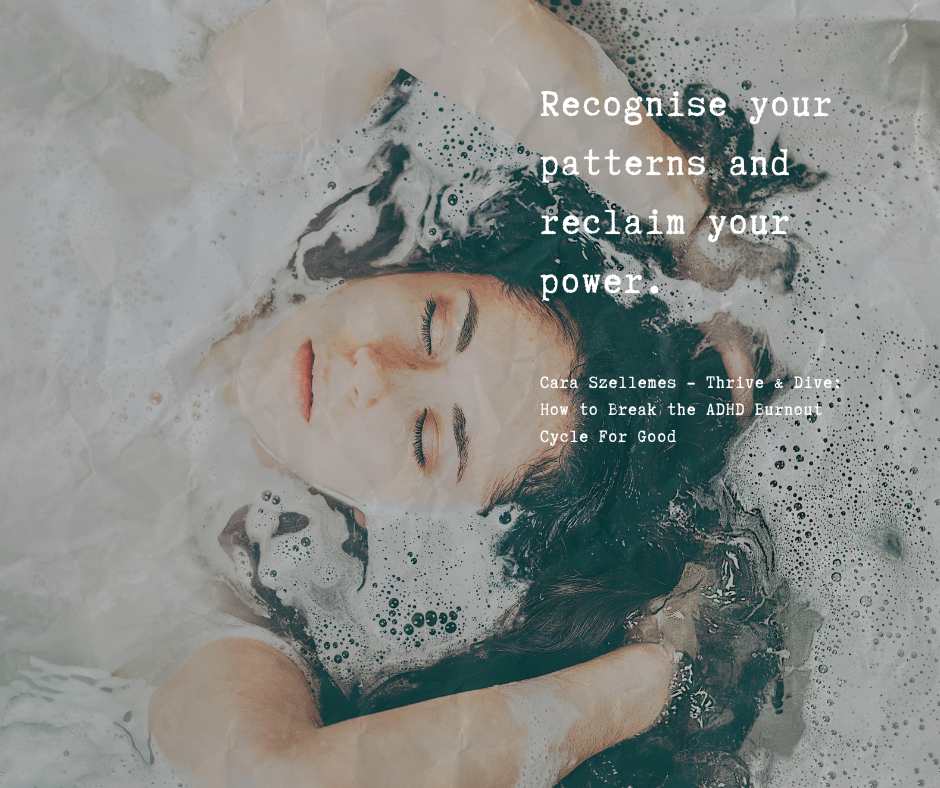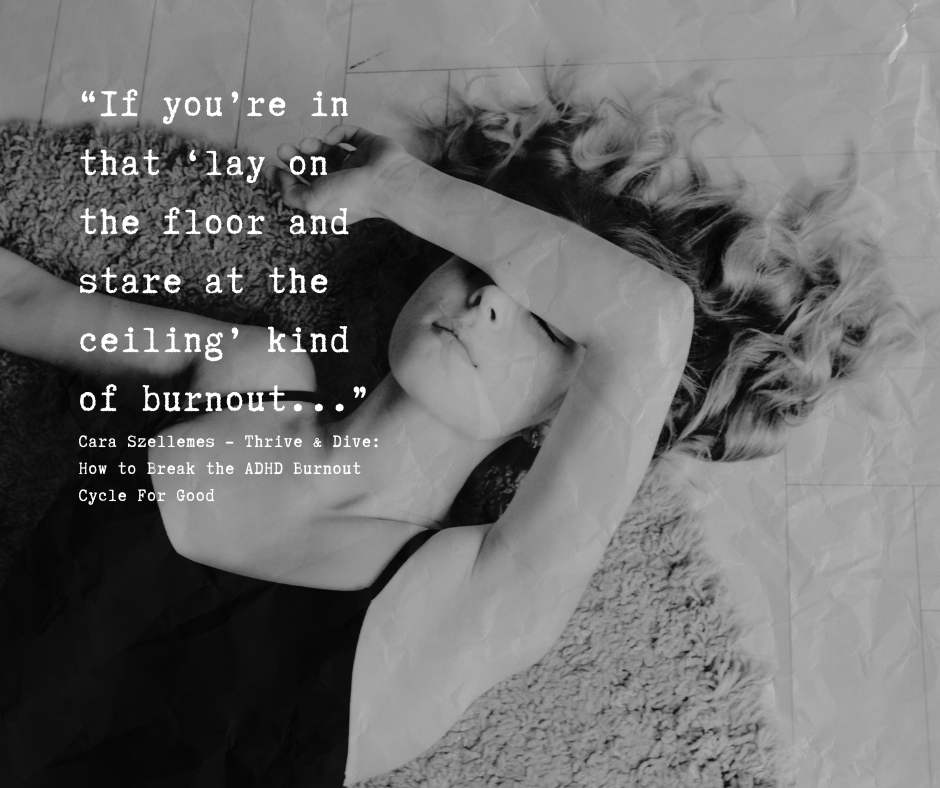
When you’re in full-blown burnout, it’s critical that you give yourself time to regroup and replenish your energy before taking big actions and making major life changes. First, you need burnout first aid.
If you’re in that “lay on the floor and stare at the ceiling” kind of burnout, here’s what has helped me re-energise one small step at a time. The following steps can help you transition through the overwhelm, and they can help whether you’re experiencing ADHD burnout or neurotypical burnout.
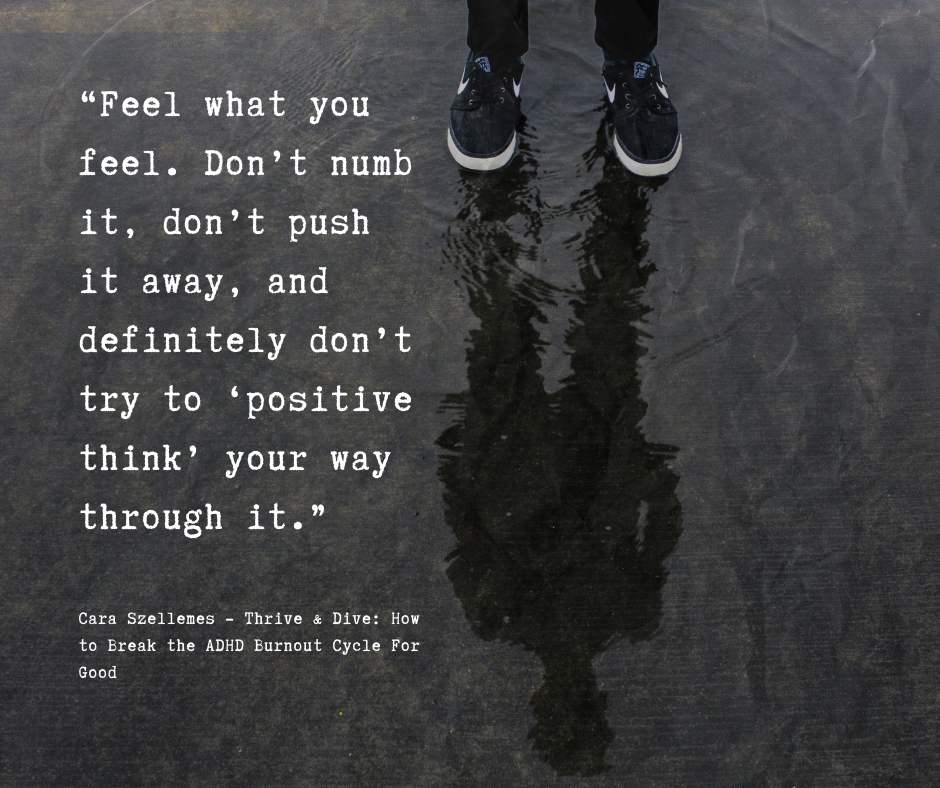
Burnout first aid step 1: Be with your emotions
It is natural to feel numb, depressed and fall into patterns of dopamine-seeking behaviours if you are in burnout. My first suggestion is to acknowledge and accept your feelings. Don’t numb them, don’t push them away, and definitely don’t try to “positive think” your way through them. It’s okay to be in grief, rage, anxiety, or self-doubt.
You’re having a normal human response to stress and loss. You’re allowed to crumble for a minute. You’re allowed to hide under the covers and sob for hours. Just remember: you will not stay here. While many researchers subscribe to the theory that emotions are stored in the body, others describe them to be more like weather systems. They roll in. They roll out. I believe both can be true. In my experience, historical traumatic events cause automatic emotional responses and also in my experience, if I go into the emotion with curiosity rather than avoid it or try to push it down, it simply disappears.
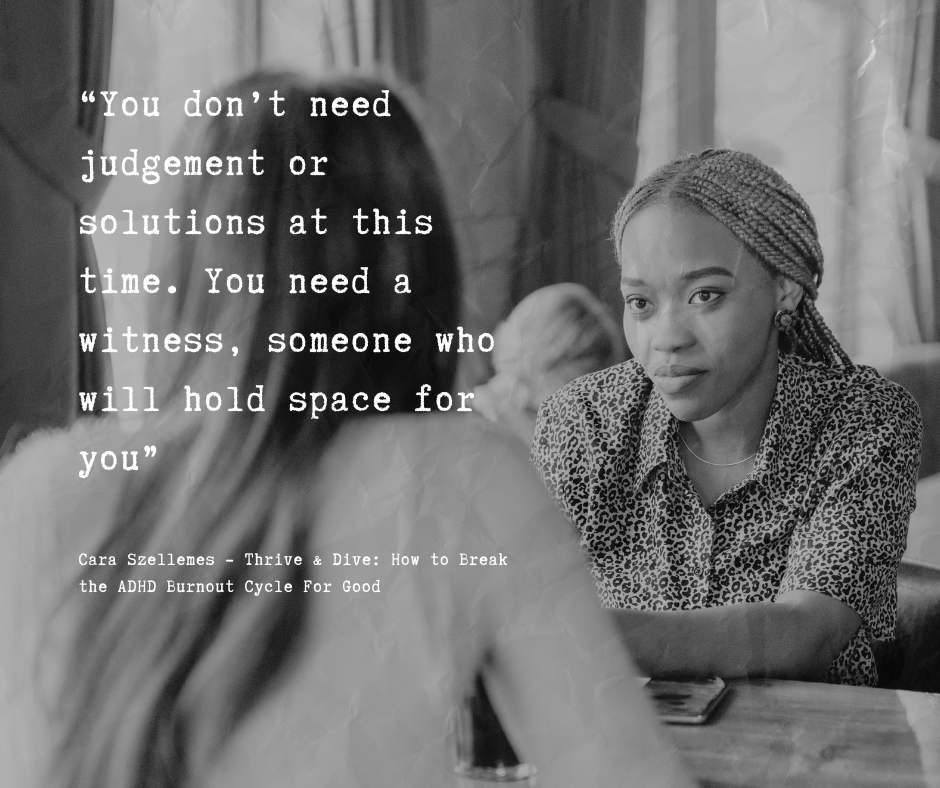
Burnout first aid step 2: Phone a friend
If people you know come at you with thought terminating cliches like “this too shall pass” or “it is what it is” or “at least you have your kids/health/money in the bank/house” it might be time to take a little break from them and focus on those in your life who can offer you support and empathy. Reach out to someone you trust who is not uncomfortable with your pain, a fixer or someone who will invalidate your experience.
You don’t need judgement or solutions at this time. You need a witness, someone who will hold space for you to express whatever is there for you in your experience, who’ll remind you you’re not alone, and help untangle the spiral if needed. That may be a friend, or you may choose to engage a professional counsellor. The point is, this is a time for prioritising relationships that feel supportive. And sometimes they may not be the people you are closest to.
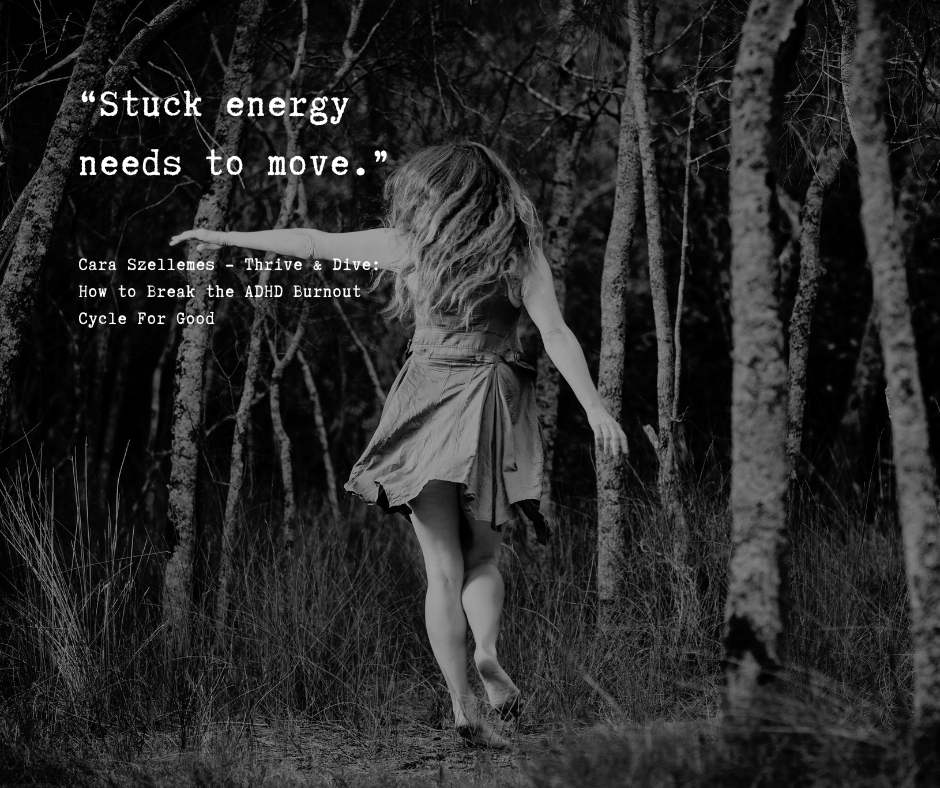
Burnout first aid step 3: Move your body
Stuck energy needs to move. Studies show that in the modern world, we simply don’t move enough, especially if we spend our working days in front of computer screens. Moving your body is part of your recovery. Whether it’s a walk, dancing in your kitchen, or a gentle stretch in bed, movement regulates your nervous system and supports mobility and flexibility. It shifts your internal state and quiets the little voice in your head.
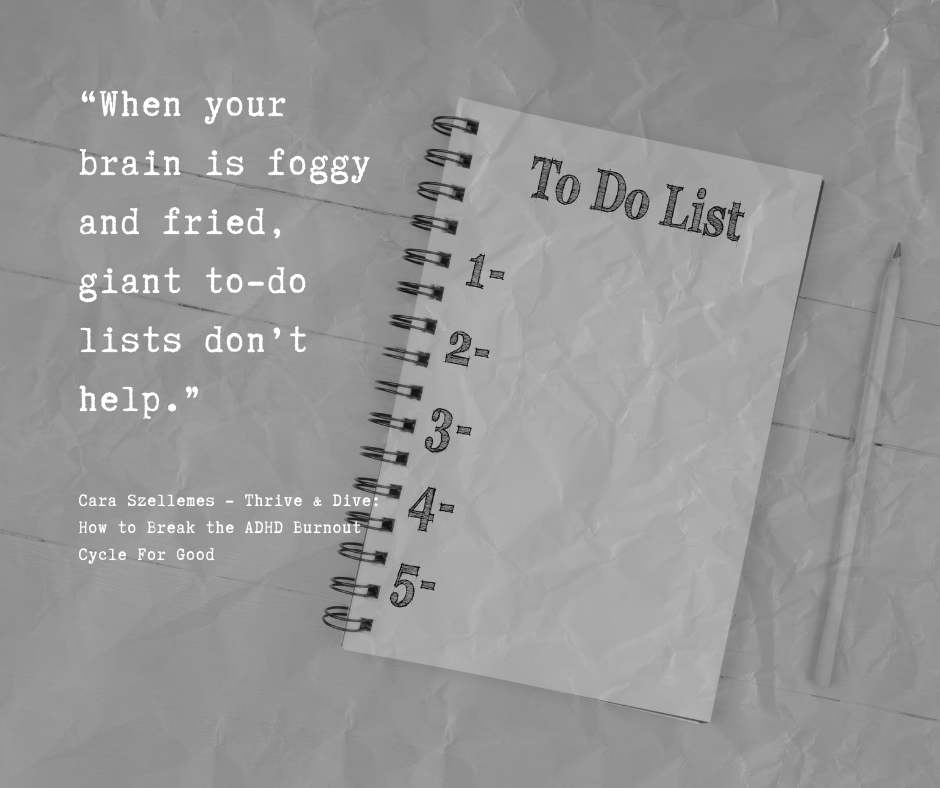
Burnout first aid step 4: Make a micro to-do list
When your brain is foggy and fried, giant to-do lists don’t help. Write down only what needs to happen in the next 24–48 hours—just the essentials. If you think of longer-term tasks, create a separate list for those, but don’t look at it until you feel ready. Start with the smallest, most achievable task. Do it. Cross it off. Repeat. Forward motion helps break paralysis.
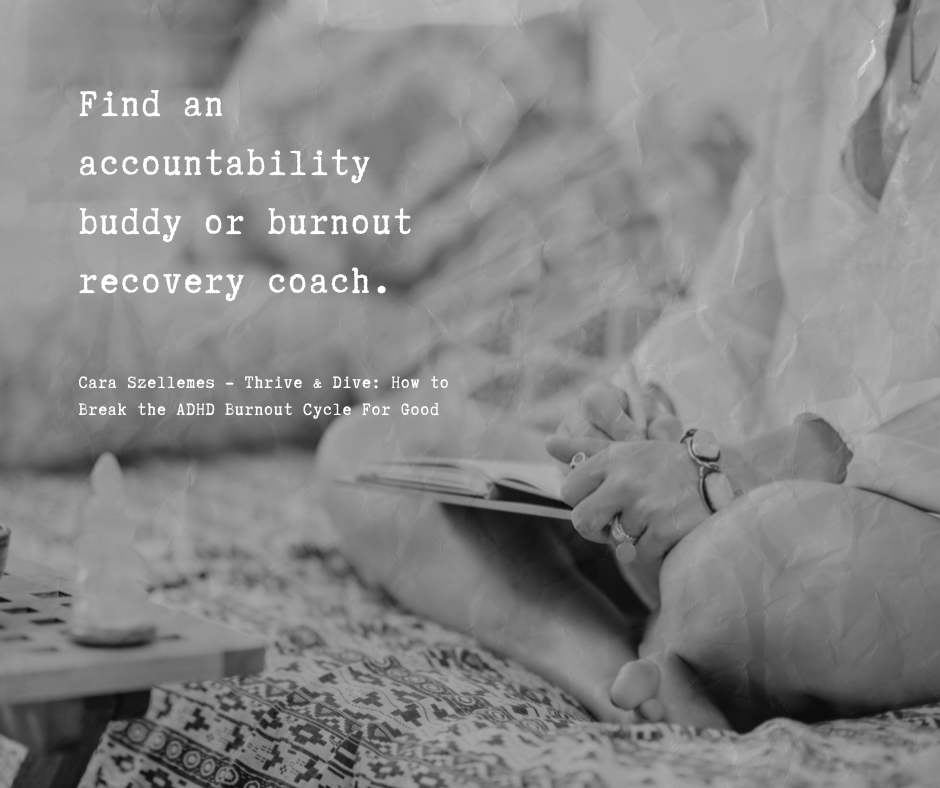
Burnout first aid step 5: Call in support
Find an accountability buddy or burnout recovery coach. This is a little different to phoning a friend. You phone a friend to share your experience and seek emotional support. However, you engage an accountability buddy to keep you on track. Whether it’s a therapist, friend or coach, having someone to check in with, encourage you, and remind you of what needs to be done and your capabilities can be a game changer when you’re stuck in burnout.
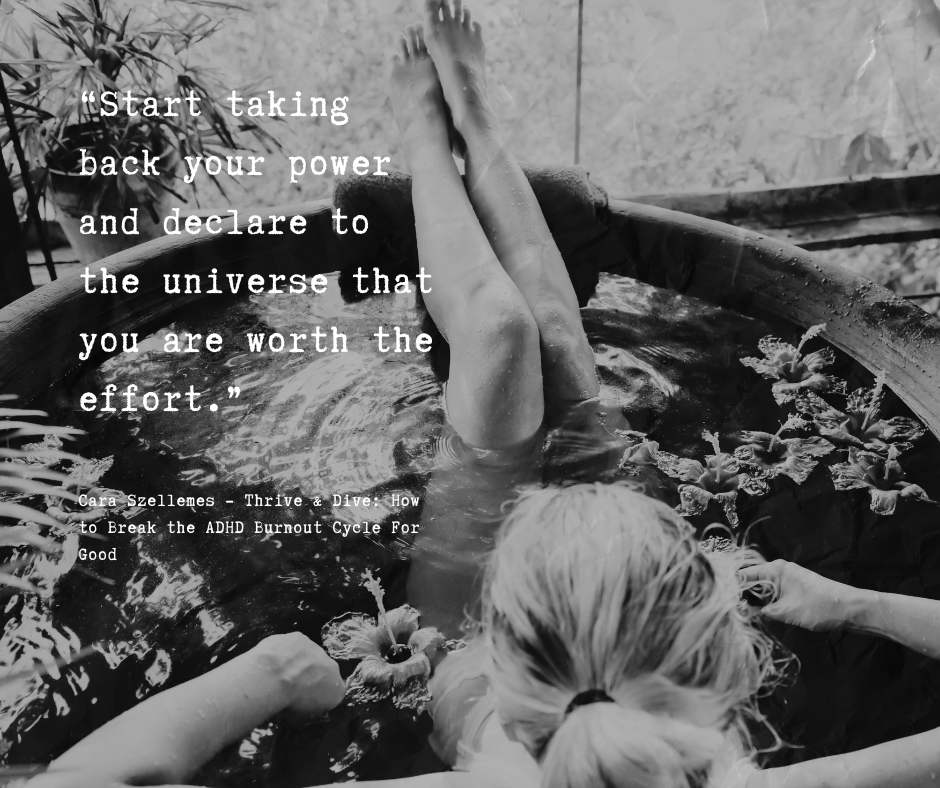
Burnout first aid step 6: Do one kind thing for yourself
Run a bath. Blend a green smoothie. Sit in the sun with a cuppa. Play with your dog. Take a moment to enjoy nature. Light a candle, or simply practice deep breathing. It doesn’t need to cost anything or take a long time. The point is to remind yourself that you matter. It’s easy to treat a friend to a massage or a movie night when they need cheering up, but it’s often hard to do these things for ourselves.
As people with ADHD, we tend to be quite hard on ourselves. We apologise for taking up space, and we feel guilty when we need others in the aftermath of a meltdown.
Doing something loving and kind for yourself is a way to start taking back your power and declaring to the universe that you are worth the effort. And if you have trouble believing that, borrow that belief from others who feel that way about you, even if it’s your dog. I don’t know one well-loved dog that doesn’t look at their owner with adoration. Borrow that adoration for yourself when you need it most.
When emerging from burnout
Once the dust settles, even just a little, you can start to shift your perspective. You may begin to see how this moment, painful as it is, might be a turning point. Maybe you didn’t choose it. Maybe it’s unfair. But maybe, just maybe, it’s also a nudge to change course.
Sometimes the universe removes the things we were too afraid to walk away from. And while the grief is real, so is the possibility that comes after it. You’re not powerless here. You get to decide what happens next, and you also get to set the pace.
But what about finances, you say? You’d be amazed at how little you can live off when you have to. After one of my burnout cycles, my ex-husband also lost his job, and for a little while. This left me with about $400 a week to feed three children. I remember selling my wedding and engagement ring set to pay the rent for one more week.
What do you have lying around that you can sell that will pay the bills for one more week? What can you cut back on?
Now is not the time to be buying lattes at the local cafe. Now is the time to be doing an inventory of your toothpaste supplies and groceries. I’m not saying you won’t find another job or get back on your feet quickly. However, if you can afford to buy yourself a little more time financially, it takes the pressure off just enough to take the next step. And that’s all you need to worry about right now. The master plan for your life can wait.
Burnout First Aid is an essential first step in your recovery from ADHD (or any other type of) burnout, but when you’re beginning to feel stronger, you’ll need some tools in your toolkit to remind you to slow down and integrate before jumping into something new so that you don’t start a new burnout cycle all over again, and in my next post, I’ll cover the first of these, Time Out.
If you’re in crisis
Don’t hesitate to call a mental health support service, especially if the thought “I don’t want to be a burden” is in your vocabulary. You deserve support. You don’t have to carry your troubles alone. Please refer to the resources below for guidance on mental health advocacy organisations and services.
- Australian Institute of Health and Welfare: Crisis Support Services Australia
- American Psychological Association: crisis hotlines
- International Association for Suicide Prevention: crisis help lines
Helpful resources
- If you haven’t already, take the ADHD Burnout quiz and find out where you are in the Thrive & Dive cycle.
- Access exclusive member content on radical self-care and support the launch of Thrive & Dive: How to Break the ADHD Burnout Cycle for Good by becoming a member of my Patreon tribe.
- Book a Burnout Recovery Discovery Session to explore working with me. I’ve developed a unique model for burnout recovery, but it’s not just for people with ADHD. It can help anyone who experiences burnout, whether that be from parenting, managing an illness or disability, or career stress. If you’re in or heading towards burnout, book a call today.
The above contains excerpts from Chapter 2 from my upcoming book, Thrive & Dive: How to Break the ADHD Burnout Cycle for Good. © 2025 Caroline Szellemes. All rights reserved.
Disclaimer: This article is for information and peer support purposes only. The information I share is not intended as a substitute for medical advice or any other kind of professional advice. Therefore, it’s your responsibility to consult with your individual qualified healthcare provider or appropriate professional if you experience any symptoms that require medical care. In an emergency, I encourage you to contact your local emergency care line (e.g. 911 in the US). I do not and cannot guarantee specific outcomes. Any application of information or material I provide is at your discretion, is solely at your own risk and is your sole responsibility.


